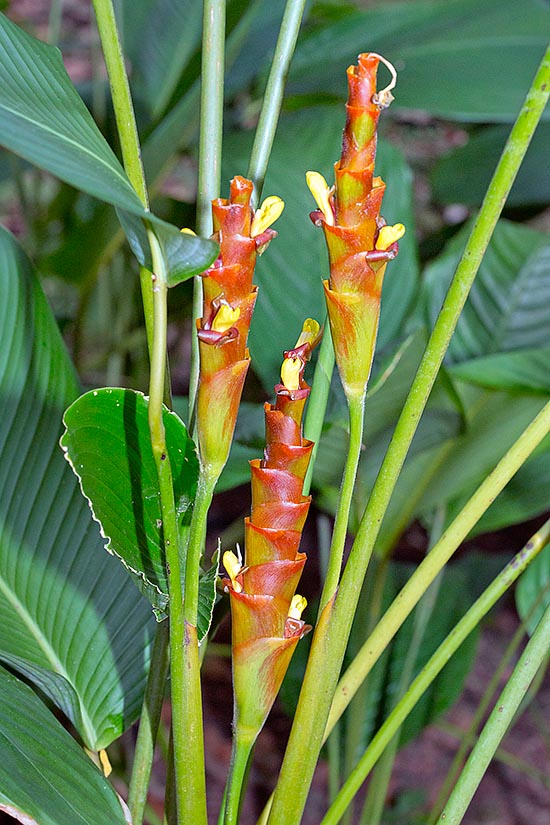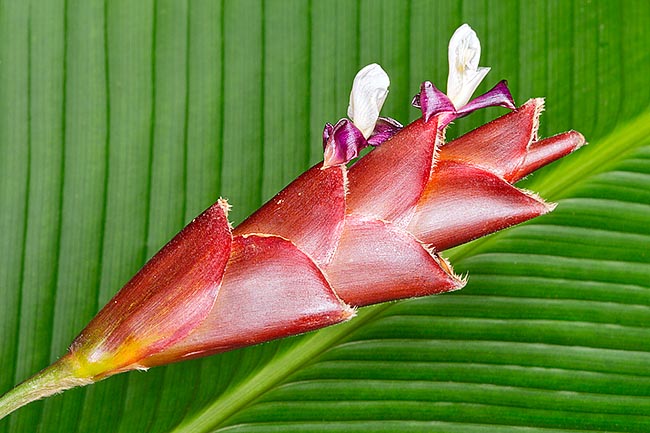Family : Marantaceae

Text © Pietro Puccio

English translation by Mario Beltramini

Calathea lutea may reach the height of 4 m © Giuseppe Mazza
The name of the genus comes from the Greek “kalathos” = basket, of unclear reference; the name of the species is the Latin adjective “luteus, a, um” = yellow, with reference to the inflorescences.
Common names: cigar calathea, Cuban cigar, Havana cigar, Mexican cigar plant (English); biao, bihao, bijagua, bijao, bihao, hoja blanca, hoja de cuero, hoja de sal, hoja de piedra, hoja de to, maxan, pampano, platanillo (Spanish); cachibou, cauassú (Portuguese Brazil).
The Calathea lutea (Aubl.) E.Mey. ex Schult. (1822) is a perennial, rhizomatous, herbaceous species, evergreen, which forms thick tufts 2-4 m tall, with pseudo stem formed by overlapped leaf sheaths.
The leaves, on a 1,2-2 m long petiole, are alternate, simple, ovate to elliptic with apex abruptly pointed, 30-100 cm long and 20-60 cm broad, coriaceous, of glossy pale green colour above and covered by a thick white powder below.
Floral scape emerging from the leaf sheath for a length of 6-18 cm ending in a more or less flattened spiky inflorescence, 10-30 cm long and 3-5 cm broad, formed by 5-12 coriaceous, imbricate, spirally arranged bracts, ovate, 3,5-5 cm long, yellowish initially, with the time turning bronze or reddish brown; the bracts contain the short lasting tubular flowers, about 4 cm long, with whitish to pale yellow staminodia and purple brown petals. The fruits are ovoid capsules containing three seeds with orange and fleshy aril. It reproduces by seed and, easily, by division of rhizomes to be interred at 3-4 cm of depth.
Species diffused all over Central and tropical Southern America of great ornamental effect due thanks to the compact tufts and the big leaves where stands out the silvery white of the lower page, cultivable in the tropical and humid subtropical climate zones in full sun as well as in partial shade. It requires soils rich of organic substance, well drained, aerated, kept humid. Where the climate does not allow permanent cultivation in open air, it can be cultivated in large containers in order to be sheltered during the coldest months in a luminous location with temperatures over the 16 °C, regular waterings, but without stagnations and allowing the surface layer of the loam to dry up before irrigating again, and fertilizations with slow-release products.

Inflorescence particular. A prized wax is gotten from the leaves © Giuseppe Mazza
Alternatively, the rhizomes can be extracted from the soil and kept in sand or dry peat and interred again when the spring comes.
The huge leaves, impermeable due to the waxy coating on the lower page, are locally utilized for wrapping cooked and raw foods and the typical “tamales” of the Mesoamerican cuisine, for realizing waterproof baskets and as cover of makeshift shelters.
The wax has characteristics of high quality comparable to that, known as carnauba, extracted from the leaves of the Copernicia prunifera, and might be commercially exploited due to the fast growth and the facility of cultivation of the plant and of collection of the waxy coating.
The inflorescences are long lasting also when cut, therefore are suitable for floral compositions.
Synonyms: Maranta lutea Aubl. (1775); Maranta disticha Buc’hoz (1783); Maranta cachibou Jacq. (1806); Maranta casupo Jacq. (1806); Calathea discolor G.Mey. (1818); Calathea lutea (Aubl.) G. Mey. (1818); Phrynium casupo (Jacq.) Roscoe (1827); Phrynium luteum (Aubl.) Sweet (1830); Calathea marantina KOCH (1857); Calathea cachibou (Jacq.) Lindl. ex Horan. (1862); Phyllodes lutea (Aubl.) Kuntze (1891); Calathea magnifica C.V.Morton & Skutch (1930).
